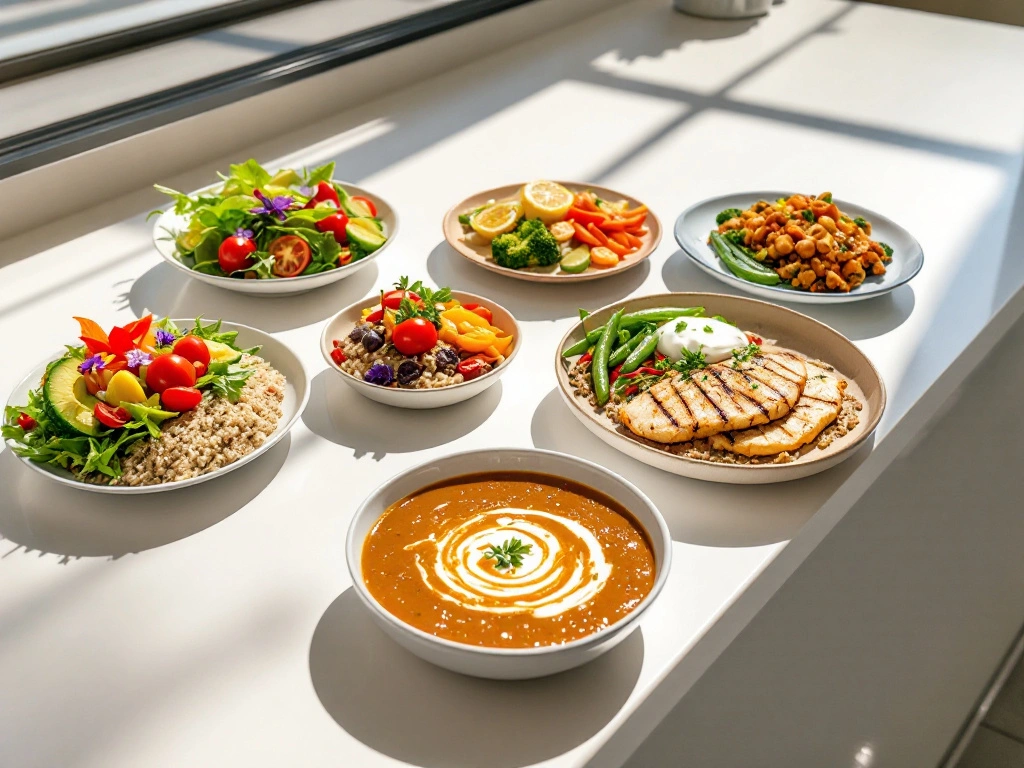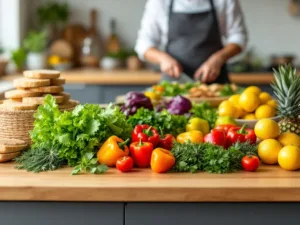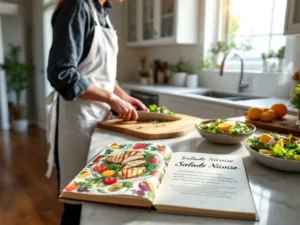How to Use Herbs and Spices to Enhance Your Healthy Food: A Comprehensive Guide to Flavor and Wellness
In a world where health-conscious eating is becoming increasingly important, the quest for flavorful yet nutritious meals is more relevant than ever. While many people associate healthy food with bland, uninspiring dishes, the truth is that the right combination of herbs and spices can transform even the simplest ingredients into a culinary masterpiece. Not only do herbs and spices add depth and complexity to your meals, but they also offer a myriad of health benefits, from boosting immunity to reducing inflammation. This article will explore how to use herbs and spices to enhance your healthy food, providing you with practical tips, examples, and insights to elevate your cooking game while supporting your well-being.
The Power of Herbs and Spices in Healthy Eating
Understanding the Difference Between Herbs and Spices
Before diving into the specifics, it’s essential to understand the distinction between herbs and spices. Herbs typically refer to the leafy green parts of plants, such as basil, parsley, and cilantro. They are often used fresh or dried and are known for their delicate flavors. Spices, on the other hand, are derived from other parts of the plant, such as seeds, bark, roots, or fruits. Examples include cinnamon, cumin, and turmeric. Both herbs and spices play a crucial role in cooking, but they are used differently to achieve various flavor profiles.
The Health Benefits of Herbs and Spices
Herbs and spices are not just flavor enhancers; they are also packed with nutrients and bioactive compounds that can promote health. For instance:
- Turmeric: Contains curcumin, a powerful anti-inflammatory and antioxidant compound.
- Ginger: Known for its anti-nausea and digestive benefits.
- Garlic: Has antimicrobial properties and can support heart health.
- Cinnamon: May help regulate blood sugar levels.
- Rosemary: Rich in antioxidants that can protect against oxidative stress.
By incorporating these and other herbs and spices into your diet, you can enjoy their health benefits while making your meals more enjoyable.
How to Use Herbs and Spices in Everyday Cooking
Building a Flavor Foundation
The key to using herbs and spices effectively is to build a flavor foundation that complements the natural taste of your ingredients. Here are some tips to get started:
- Start with Aromatics: Aromatics like garlic, onions, and ginger form the base of many dishes. Sautéing these ingredients at the beginning of cooking releases their flavors and creates a rich foundation for your meal.
- Layer Flavors: Add herbs and spices at different stages of cooking to build complexity. For example, add hardy herbs like rosemary and thyme early in the cooking process, while delicate herbs like basil and cilantro are best added at the end.
- Balance Flavors: Aim for a balance of sweet, salty, sour, and bitter flavors. For example, a pinch of cinnamon can add sweetness to a savory dish, while a squeeze of lemon juice can brighten up a rich, spicy curry.
Pairing Herbs and Spices with Ingredients
Different herbs and spices pair well with specific ingredients. Here are some classic combinations to inspire you:
- Chicken: Thyme, rosemary, sage, and garlic.
- Fish: Dill, parsley, lemon zest, and fennel seeds.
- Beef: Black pepper, cumin, coriander, and bay leaves.
- Vegetables: Basil, oregano, turmeric, and paprika.
- Grains: Cumin, coriander, cardamom, and saffron.
Experimenting with these pairings can help you discover new flavor combinations that enhance your meals.
Practical Tips for Using Herbs and Spices
- Use Fresh Herbs When Possible: Fresh herbs have a more vibrant flavor than dried ones. If you’re using dried herbs, remember that they are more concentrated, so you’ll need less.
- Toast Spices for Enhanced Flavor: Toasting spices in a dry pan before using them can release their essential oils and intensify their flavor.
- Store Herbs and Spices Properly: Keep them in a cool, dark place to preserve their potency. Avoid storing them near the stove, as heat and moisture can degrade their quality.
- Grind Your Own Spices: Whole spices retain their flavor longer than pre-ground ones. Invest in a spice grinder or mortar and pestle to grind your spices as needed.
Exploring Global Cuisines Through Herbs and Spices
Mediterranean Cuisine
Mediterranean cuisine is renowned for its use of fresh herbs and spices, which contribute to its health benefits and vibrant flavors. Key ingredients include:
- Olive Oil: Often infused with herbs like rosemary and thyme.
- Tomatoes: Enhanced with basil, oregano, and garlic.
- Seafood: Seasoned with dill, parsley, and lemon.
A classic Mediterranean dish like Greek salad showcases the power of fresh herbs, with ingredients like cucumbers, tomatoes, and feta cheese brought to life with a sprinkle of oregano and a drizzle of olive oil.
Indian Cuisine
Indian cuisine is a treasure trove of spices, each contributing to the complex flavors and health benefits of the dishes. Common spices include:
- Turmeric: Used in curries for its color and anti-inflammatory properties.
- Cumin: Adds a warm, earthy flavor to dishes.
- Coriander: Both the seeds and leaves (cilantro) are used extensively.
- Cardamom: Adds a sweet, floral note to both savory and sweet dishes.
A dish like chicken tikka masala exemplifies the use of spices, with a blend of cumin, coriander, turmeric, and garam masala creating a rich, flavorful sauce.
Middle Eastern Cuisine
Middle Eastern cuisine is characterized by its use of aromatic spices and herbs, which add depth and warmth to the dishes. Key ingredients include:
- Sumac: Adds a tangy, lemony flavor to salads and meats.
- Za’atar: A blend of thyme, sesame seeds, and sumac, used as a seasoning.
- Cumin and Coriander: Often used together in spice blends like baharat.
A dish like falafel, made from ground chickpeas and seasoned with cumin, coriander, and parsley, is a perfect example of how herbs and spices can elevate simple ingredients.
Latin American Cuisine
Latin American cuisine is known for its bold flavors, achieved through the use of herbs and spices. Key ingredients include:
- Cilantro: Used extensively in salsas and marinades.
- Cumin: Adds a warm, earthy flavor to dishes.
- Chili Peppers: Provide heat and depth to sauces and stews.
A dish like ceviche, made with fresh fish marinated in lime juice and seasoned with cilantro and chili peppers, showcases the vibrant flavors of Latin American cuisine.
The Role of Herbs and Spices in Health and Wellness
Boosting Immunity
Many herbs and spices have immune-boosting properties. For example:
- Echinacea: Often used in herbal teas to support the immune system.
- Elderberry: Known for its antiviral properties.
- Garlic: Contains allicin, which has antimicrobial effects.
Incorporating these herbs and spices into your diet can help strengthen your immune system, especially during cold and flu season.
Reducing Inflammation
Chronic inflammation is linked to many health conditions, including heart disease and arthritis. Herbs and spices with anti-inflammatory properties can help mitigate this risk:
- Turmeric: Contains curcumin, a potent anti-inflammatory compound.
- Ginger: Known for its anti-inflammatory and pain-relieving effects.
- Cinnamon: May help reduce inflammation and improve blood sugar control.
Adding these spices to your meals can help reduce inflammation and promote overall health.
Supporting Digestive Health
Herbs and spices can also support digestive health by stimulating digestion and reducing symptoms like bloating and indigestion:
- Peppermint: Known for its ability to soothe the digestive tract.
- Fennel: Often used to relieve bloating and gas.
- Ginger: Helps with nausea and digestion.
Incorporating these herbs and spices into your diet can help maintain a healthy digestive system.
Enhancing Mental Health
Certain herbs and spices have been shown to have a positive impact on mental health:
- Saffron: May help alleviate symptoms of depression.
- Lavender: Known for its calming and relaxing effects.
- Ashwagandha: An adaptogen that helps reduce stress and anxiety.
Using these herbs and spices in your cooking or as supplements can support mental well-being.
Practical Tips for Incorporating Herbs and Spices into Your Diet
Start Small
If you’re new to using herbs and spices, start with small amounts and gradually increase as you become more comfortable. This will help you avoid overwhelming your palate and allow you to appreciate the subtle flavors.
Experiment with Blends
Spice blends, such as curry powder, garam masala, and herbes de Provence, can simplify the process of seasoning your dishes. Experiment with different blends to discover new flavors.
Use Herbs and Spices in Beverages
Herbs and spices can also be used to enhance beverages. For example:
- Mint: Adds a refreshing flavor to water and tea.
- Cinnamon: Can be sprinkled on coffee or hot chocolate.
- Ginger: Adds a spicy kick to smoothies and juices.
Incorporate Herbs and Spices into Snacks
Herbs and spices can elevate even the simplest snacks. For example:
- Popcorn: Sprinkle with nutritional yeast, paprika, and garlic powder for a savory treat.
- Roasted Nuts: Toss with cinnamon and a touch of honey for a sweet and spicy snack.
- Hummus: Add cumin, paprika, and fresh parsley for extra flavor.
Grow Your Own Herbs
Growing your own herbs is a cost-effective way to ensure a fresh supply. Herbs like basil, parsley, and mint are easy to grow in pots and can be used in a variety of dishes.
Conclusion: Elevate Your Healthy Food with Herbs and Spices
Incorporating herbs and spices into your diet is a simple yet powerful way to enhance the flavor and nutritional value of your meals. By understanding the unique properties of different herbs and spices, you can create dishes that are not only delicious but also supportive of your health and well-being. Whether you’re exploring global cuisines, experimenting with new flavor combinations, or simply looking to add a burst of flavor to your everyday meals, herbs and spices offer endless possibilities.
As you embark on your culinary journey, remember to start small, experiment with different blends, and enjoy the process of discovering new flavors. With the right combination of herbs and spices, you can transform your healthy food into a feast for the senses, proving that nutritious eating doesn’t have to be boring. So, go ahead—spice up your life and savor the benefits of a flavorful, healthful diet.









Add comment